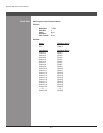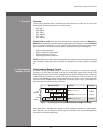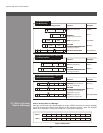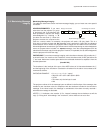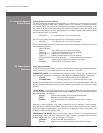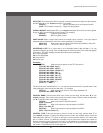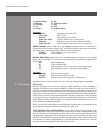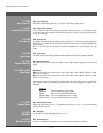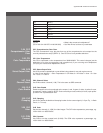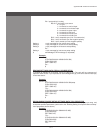
Wolf Cinema Owner's Manual
B-10
0 = Special Format 5 = Text
1= Slide Bar 6 = “Reserved Control”
2 = Checkbox 7 = Date
3 = List 8 = Time
4 = Number 9 = IP (dotted quad)
Examples:
(STD?T) What type of control is STD?
(STD! T003) STD is a List.
(CON?T) What type of control is CON?
(CON! T001 %000) CON is a slidebar that is currently at 0%.
(EBB?T8) What type of control is index parameter 8 of EBB?
(EBB! T004 237) EBB is a number control and it’s current value is 237.
ENABLE INQUIRY: Add the letter “E” in your request messageto ndout if thecontrol is
enabled in the current context. A reply of “001” is returned if enabled. If the control has and index
for multiple values, that index should be used to read the enable status.
(STD?E) Is STD enabled in the current context?
(STE!E001) STD is enabled.
KEYPAD EMULATION: Add the letter “K” in your set message to change to a quick “keypad
mode” within the message. The next value in the message now represents the adjustment of
the parameter.
K0 Stop the adjustment
K1 Toggle check box state
K2 Start decreasing a value, or moving the current image left/up
K3 Start increasing a value, or moving the image right/down
Examples:
(LHO K2) Start moving the image left
(LHO K0) Stop moving the image horizontally
(FRZ K1) Freeze or unfreeze the image on the active window
Keypad emulation is required in APR, FCS, LHO, LVO and ZOM messages set messages.
Flow Control
Normally messages can be sent to the projector before processing of earlier messages is
complete—the projector will just store messages in a buffer until ready to process. However, if
a series of messages is sent it is possible that the projector may not be able to process them as
fast as they arrive and the buffer will become full. If this happens, the projector will send the 13h
(Xoff) code to instruct the controller (or any devices preparing to transmit) to cease transmission.
At this point, the controller must respond immediately and send no more than 10 extra characters
or they may be lost (i.e., the projector is able to accommodate the receipt of up to 10 more bytes
after it sends 13h [Xoff]). When the buffer is once again available, the projector will send a 11h
(Xon) command to resume transmission.
NOTE: Xon and Xoff controls apply to both directions of communication. The projector will not
send more than 3 characters after it has received a 13h (Xoff) code.
FLOW CONTROL WITH “ACKNOWLEDGE”: If the controller waits for each message to be
acknowledged before sending the next and the controller does not send a message that is longer
than 20 characters, then the projector will never send an Xoff and the controller does not have
to handle them. If the projector has not received an Xon after receiving an Xoff code, after a time
out it will assume that the Xon was lost and start transmitting again. If the controller has received
an Xoff and no Xon within a reasonable time, it can assume that the Xon was lost. These two
timeoutsareprojector-specicandareintherangeof3s-60s.
2.7 Flow Control
AppendixB►SerialCommunications



